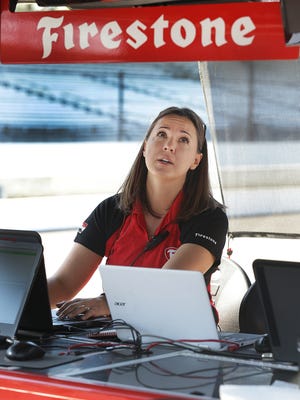Cara Adams is the only female chief engineer in IndyCar, now she wants more to join her

Cara Adams isn't in marketing. It took some time for drivers to realize that.
Adams was the only female engineer in the IndyCar pits when she started at Firestone Racing in 2008. Sometimes she would ask drivers questions about the tires' performance and receive generic praise about them.
Drivers thought they were responding to a marketing or public relations person.
Adams said she had to earn their respect. She learned to start asking more specific, technical questions, such as how the "mid to exit understeer" of the tire compared to last year’s. Then, they realized she was looking for specific, technical answers. She was there to make them go faster.
That respect came over time. Soon Adams would tell a driver something and they would nod. She would overhear one driver tell another “Well, Cara said this,” and she would know she’s earned it.
“I know I have that respect," she said, "and I don’t take that lightly.”
MORE RACE COVERAGE
Test your Indy 500 knowledge
Adams now is chief engineer of Bridgestone Americas Motorsports and manager of race tire development. She’s the only female chief engineer in the sport. Right above her is another powerful woman, Lisa Boggs, Director of Bridgestone Americas Motorsports.
Both women could be considered trailblazers in a male-dominated field, but they become almost uneasy when trying to talk about rising through the sport as women. To them, being a different gender was a non-issue. They are the best people for the jobs.
But they have come to realize there’s still an importance to their success.
“I think we’ve actually come to embrace it instead of saying, ‘Why should it really matter?’ It does matter, and it actually matters in a really good way,” Boggs said.
That good way is that women need more role models in these positions to create more change in the field. Adams and Boggs have the chance to be mentors for young women to look up to.
“I think you develop more females in motorsports by having those mentors,” Adams said, “by having people that are not afraid to talk about what they do and help other people out.”

Adams had an easy time finding those mentors. Her mother was a science teacher and her grandfather was an engineer for launch teams at NASA. She said she grew up without any preconception of what a woman should or shouldn’t be doing.
Adams mother put her in neighborhood science camps and took Adams to the butcher and asked for cow eyeballs so she could learn how an eyeball worked. They examined Wint-O-Green LifeSavers to see their phosphorescence.
“I’ve always loved science, and it was passed down to me and I love to pass it down to other people,” Adams said.
Adams didn’t grow up a race car fanatic. She’d occasionally watch her dad rebuild a carburetor, but Adams grew up a science fanatic and stumbled into racing when she walked into the Formula SAE shop at the University of Akron, where students learn how to design and produce a prototype formula-style racecar. She began working with the team and learning the ropes.
She took a job with the Tire Vehicle Dynamics team for Firestone, but she missed the excitement of working in racing. She approached the race team hiring manager about what skills he would look for in an engineer.
The skills: An understanding of vehicle dynamics, Force and Moment testing and programming. She had the first one down, but she had to learn the next two.
Adams bought books on the topics and studied for years to learn everything she could. She took rigorous notes and questioned everyone she could to gain as much of an understanding as possible. When the job opened up, she wanted the company to have no choice but to hire her.
That’s the biggest thing people often bring up about Adams: her constant desire to learn and ask questions.
“She goes the extra mile, above and beyond, to always question and learn, which tells you the story of how she went and learned everything she could to get the job,” Boggs said. “She never stopped that.”
Boggs said Adams is the kind of person who takes time to evaluate the situation and figure out not just the next step, but the next three steps. It’s that kind of drive that has her doing Iron Man triathlons.
“I think that anybody that’s involved in racing, first of all, probably loves cars, but second of all loves to compete, loves to see the best version of themselves,” Adams said.
It’s that same drive that helps Adams be the role model she’s realized she should be.
A young college student approached Adams at the Milwaukee Mile and asked whether Adams had any advice for getting into racing. They exchanged information and kept in touch throughout the years. Adams helped however she could, and the woman was able to volunteer for race teams off and on.
She’s now an engineer at Harley Davidson.